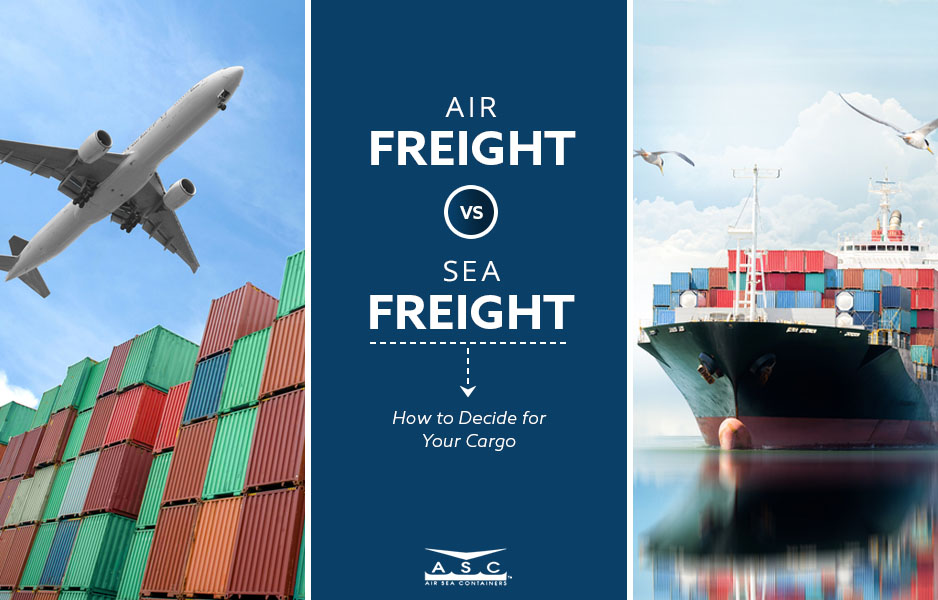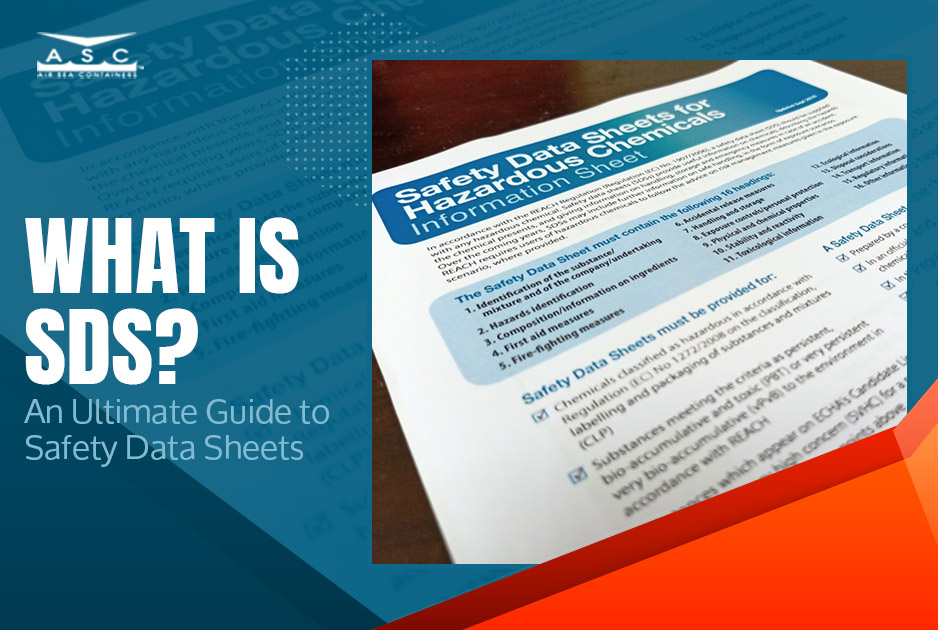Summary
- Numerous international and domestic organizations regulate air and sea freight, such as the IATA, FAA and DOT.
- Air freight is ideal for smaller, low-volume cargo, whereas sea freight is suitable for large quantities and bulk cargo.
- Shipping by air is faster and ideal for urgent deliveries, yet costly and highly polluting.
- Shipping by sea is more economical but can take up to a month to reach its destination.
The most common international shipping methods are air freight and sea freight. Although both are suitable for shipping cargo to overseas destinations, each is governed by different laws and regulations and has varying logistical considerations.
Learn about the practical and legal aspects of air and sea freight and evaluate the pros and cons of each shipping method to determine which meets your specific requirements and resources.
How Air Freight Works
Air freight (also called air cargo) is the transportation and delivery of goods by aircraft, either via a commercial or a charter carrier. According to the latest statistics, worldwide air freight traffic is steadily growing, surpassing 60 million metric tons shipped for the first time in 2018 and projected to reach 69.3 million by the end of 2022.
Air Freight Vehicles and Capacity
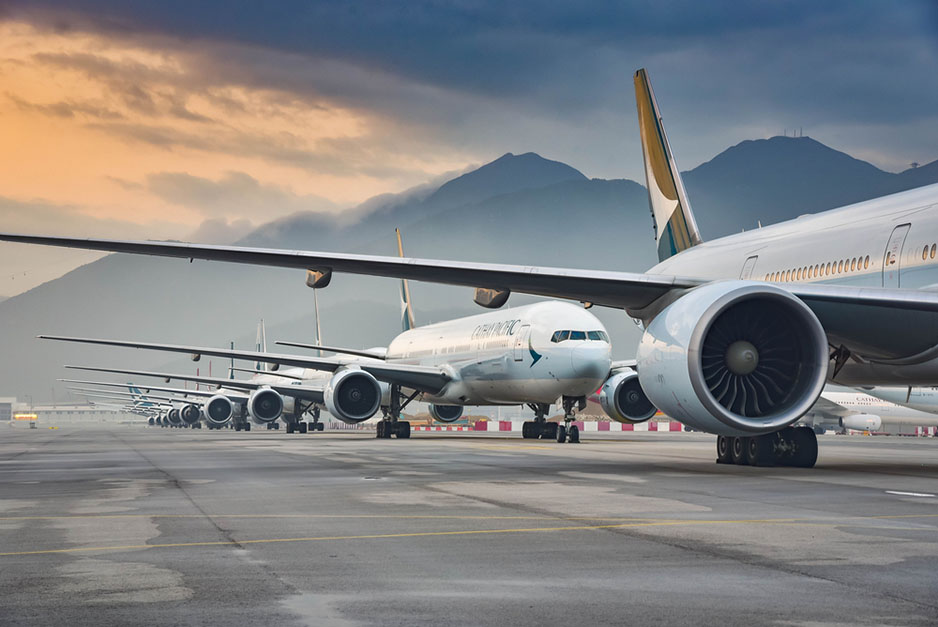
International air cargo is typically delivered using one of four methods:
- Passenger aircraft, in the cargo hold of a typical airliner (e.g., Boeing 747-400)
- Combi aircraft: Passenger airliners that can convert some of their passenger compartments into cargo holds, increasing their freight storage capabilities
- Dedicated cargo-only planes (e.g., Airbus A330-200F)
- Supercargo planes (e.g., Antonov An-225)
Passenger airliners typically transport small quantities of cargo in a dedicated cargo hold. Since the primary purpose of these planes is transporting passengers, the cargo hold space is generally limited to no more than 100-150m³ of cargo, shared with passenger luggage. The most common types of freight transported in passenger airliners are mail and postal packages.
A typical international cargo-only plane does not have to divide its available space between cargo and passengers. This gives them a maximum cargo capacity ranging between 100m³ and 500m³.
Combi aircraft are designed for mixed passenger and cargo transportation. Operators can quickly convert internal sections of the plane to support passengers or cargo as necessary. This type of aircraft is typically built on the same platforms as standard airliners (e.g., Boeing 737-400C), possessing a maximum cargo capacity between a passenger plane and a cargo-only plane (250-300m³).
Supercargo planes (also known as super-transporters) have extra-large doors and gates, generally intended for extra-heavy payloads. Their maximum cargo capacity depends on the plane’s model but frequently exceeds 1,000m³. Some, such as the Airbus Beluga XL, can even carry over 2,000m³ of merchandise.
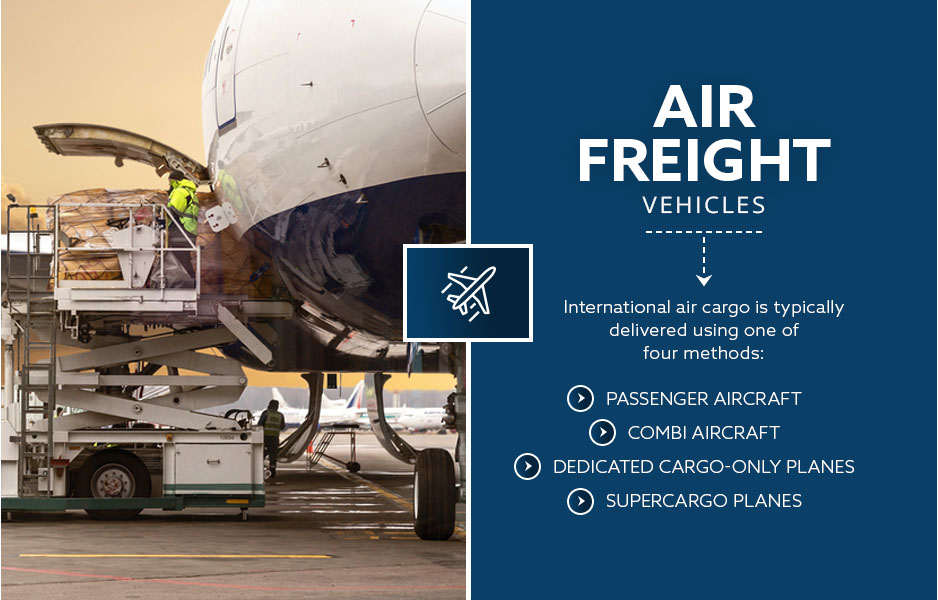
What You Can Ship by Air
All air freighters can carry small packages, parcels and boxes in dedicated containers called Unit Load Devices (ULD). A ULD is the air freight equivalent of a naval intermodal container. Multiple sizes and types are available, each suited for different airplane cargo holds.
Larger, palletized containers, such as a gaylord box mounted on a pallet, require dedicated space in a combi or cargo-only plane. Palletized containers are typically the largest single packaging type a typical air freighting plane can transport.
However, the inside of a typical cargo plane does not allow forklifts to enter and exit the cargo hold because there is no space to maneuver. Instead, the cargo hold floor features electric rolling tracks that move cargo in and out.
Super-transporters can carry special extra-large bulk cargo, such as cars, trucks, large drums, parts of large vehicles or even small aircraft.
Air Freight Rules and Regulations
Although you can move a wide range of cargo by air, several critical international laws and regulations apply to air freight.
The International Air Transport Association (IATA) is a trade association representing 288 airlines in 112 countries, totaling over 80 percent of all air traffic worldwide. This organization is responsible for publishing and updating all air freight rules, guidelines and regulations. The IATA Dangerous Goods Regulations (DGR) manual contains the latest regulations and policies on air transportation of hazardous materials.
Although IATA creates and updates regulations, they are not a regulatory body and do not possess the authority to enforce them. Instead, the responsibility falls on each country’s air transportation authorities.
For instance, in the United States, the primary agency responsible for enforcing applicable IATA regulations is the Federal Aviation Administration (FAA), under the purview of the Department of Transportation (USDOT). The rules outlined in the IATA DGR are mirrored in U.S. law (Title 49 of the Code of Federal Regulations, better known as 49 CFR), making them enforceable law.
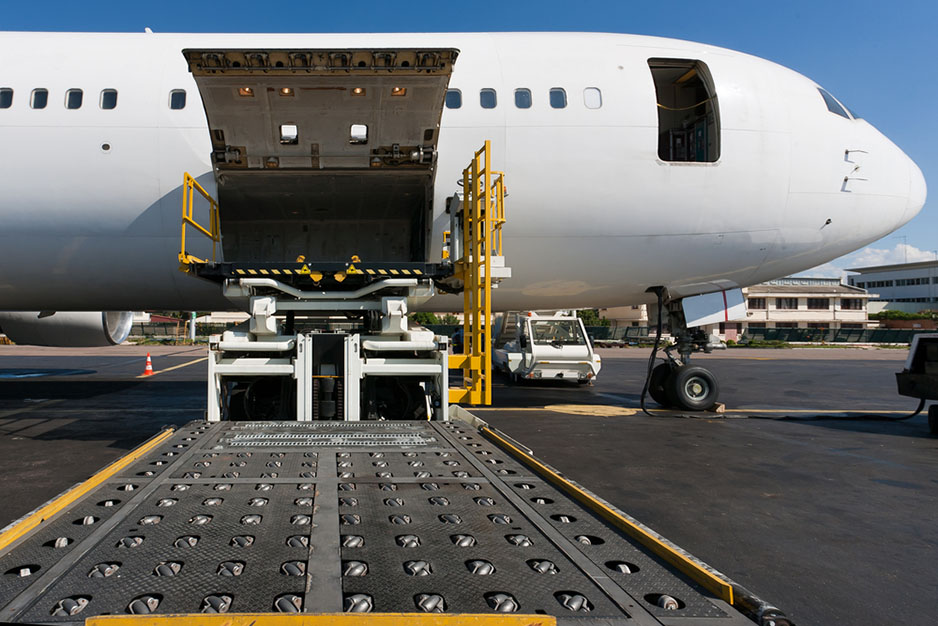
Air Shipping Process
The air shipping process typically follows seven basic steps.
1. Chargeable weight calculation
Before the sender entrusts their cargo to a shipper, they must determine its chargeable weight.
The chargeable weight is either based on its actual gross weight (using a unit of mass, such as kg or lbs.) or its volumetric weight (a nominal weight based on the volume it occupies).
First, measure the package’s full dimensions: length, width, height. Then, weigh it to obtain its actual gross weight. Use the dimensions to calculate the package’s volumetric weight according to the following formulas:
- Metric: Multiply the length, weight and height in meters and then multiply the result by 166.667 to obtain the volumetric weight in kilograms. (e.g., 1 x 1.2 x 1 x 166.667 = approximately 200)
- Imperial: Multiply the length, weight and height in inches and then divide the result by 166 to obtain the volumetric weight in pounds. (e.g., 20 x 25 x 20 / 166 = about 60.24)
Compare the volumetric weight of your package with its actual gross weight. The chargeable weight is the highest value of the two.
- Example: If your package’s dimensions are 1m x 1.2m x 1m, its volumetric weight is 200 kg. If the actual gross weight is less than 200 kg, you will be charged based on the volumetric weight of 200 kg; otherwise, your chargeable weight is based on the actual gross weight.
Shop Gaylord Boxes and Other Corrugated Containers
2. Cargo registration and pickup
After calculating the cargo’s chargeable weight, the sender provides documentation to the shipper, such as the commercial invoice and certificate of origin. The type and quantity of documentation vary depending on the country of origin and destination, the kind of cargo shipped and the shipper’s terms and conditions.
Once the shipper confirms all the details, they pick up the sender’s shipment and then transport it by land to one of their warehouses.
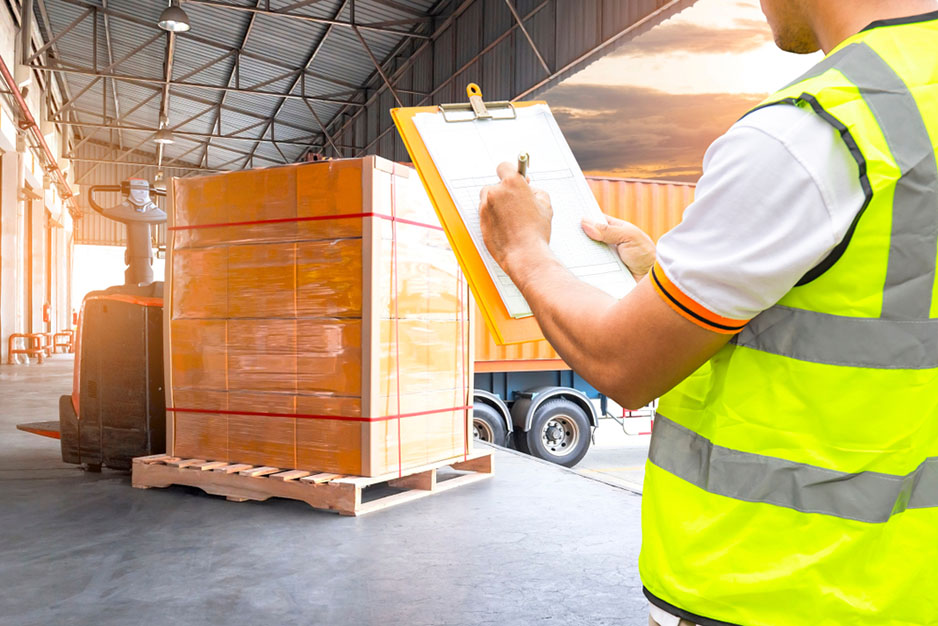
3. Warehouse processing and air waybill issuance
Cargo arriving at a shipper’s warehouse typically undergoes quality control (QC) checks, ensuring that the package is properly packaged and ready for shipping. If it passes QC, the shipper applies appropriate labeling and sends an air waybill (AWB) to the customer.
The AWB contains standard shipping information: Sender’s name and address, consignee’s name and address, origin airport, destination airport, cargo description and other data and special instructions. Once the sender confirms and signs the AWB, it acts as a legally binding contract between the sender and the shipping company.
4. Origin customs clearance
After confirming that both parties have signed the AWB, the cargo is ready to be shipped by air. The shipper sends it to the origin airport, where it undergoes all appropriate checks and inspections.
5. Stowage and air transportation
Once cleared by customs, airport staff loads the cargo into an appropriate transportation aircraft, either into a ULD (if not palletized) or directly into a cargo bay (if palletized). The plane then departs from the origin airport and journeys to the destination airport.
6. Unloading and destination customs clearance
Once the aircraft has arrived at the destination airport, the cargo is unloaded and sent to the destination airport’s customs processing. The shipment undergoes all applicable checks and verifications for the destination country. Typically, the more similar the rules between the origin and destination countries, the faster this process is.
7. Final delivery
After the destination country’s customs services clear the cargo, the shipper completes the delivery and ships it to the consignee via land transportation, typically by rail or road.
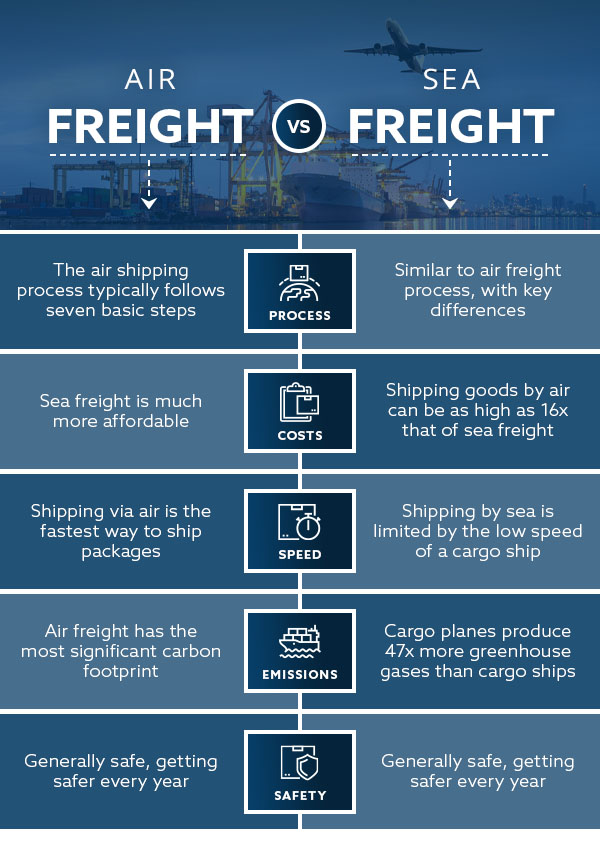
How Sea Freight Works
Sea freight (also called ocean freight) is a method of transportation and delivery of goods employing specialized, ocean-faring cargo vessels. In 2020, the worldwide sea freight industry was estimated to be worth approximately $500 billion.
Sea freight vehicles and capacity
Although there are many types of sea freight vessels, here are the three most common:
- Container ships, primarily designed to transport intermodal containers
- Roll-On/Roll-Off (RORO) ships, designed to transport land vehicles
- Bulk carriers, designed to transport large quantities of bulk, unpackaged goods
Container ships are easily recognizable by their piles of intermodal containers stored on the bridge. According to the latest estimates, container ships carry 90 percent of all sea-faring non-bulk cargo worldwide.
The unit of measurement of cargo capacity is the Twenty-foot Equivalent Unit (TEU). One TEU roughly corresponds to the volume of a single 20-foot intermodal container. Most container ships in operation today can carry between 10,000 and 20,000 TEU, with the largest models (e.g., Evergreen A-class) capable of reaching a theoretical maximum of 24,000.
RORO ships are unique transport vessels with drivable ramps, accessways and internal cargo space, making it possible to drive or push cars, trucks and other ground vehicles directly on and off the ship. An average RORO ship can transport 4,000 to 5,000 cars, with some possessing enough space for up to 8,000 vehicles.
Bulk carriers can transport any cargo that doesn’t fit in a container. Their role is to transport large quantities of specific types of raw materials, such as grain, ore, sand, gravel, wood chips and other similar resources.
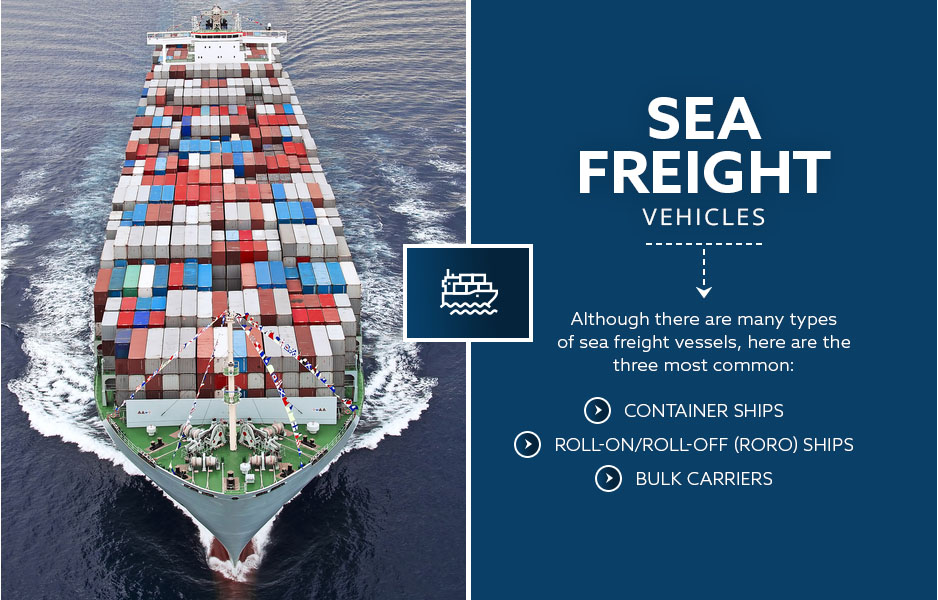
What you can ship by sea
Virtually any type of cargo can be transported by sea. The most common method of transportation is via intermodal containers. An intermodal container is designed to be transported on a cargo or container ship. It can contain various package types: boxes, crates, pallets and drums equipped with spill containment trays.
Find Spill Containment Trays at Air Sea Containers
Intermodal containers are a highly efficient way to transport goods because transport companies can use them on land and sea. Their rectangular shape makes storing them on a vessel easy. In addition, land vehicles like semi-trailer trucks and trains can accept and transport them without modification.
Vehicles can either be containerized like regular cargo or transported via RORO ship. RORO shipping allows an operator to drive the vehicle cargo directly on and off the vessel without needing a container and a separate transport vehicle.
Sea freight rules and regulations
The International Maritime Organization (IMO) is the sole agency responsible for regulating international sea freight and maritime shipping. The IMO is a United Nations Specialized Agency, with a status equivalent to the International Monetary Fund (IMF) or the World Health Organization (WHO).
The IMO is responsible for creating and enforcing maritime law, including sea freight rules and regulations. Enforcement of these laws is the responsibility of its 174 member-states, who must codify each new IMO rule and policy into their respective legal systems.
The list of current IMO publications is regularly updated (typically yearly or biyearly) and includes rulebooks, such as the International Maritime Dangerous Goods (IMDG) Code.
The IMDG outlines the rules and regulations surrounding sea transportation of hazardous materials and is updated every two years.
Sea Shipping Process
The sea shipping process is relatively similar to the air freight process, with the following key differences:
- Shipping contracts must typically follow one of the 11 possible International Commercial Terms (Incoterms) applicable to sea freight. Incoterms define the legal responsibilities assigned to the buyer and the seller and must be mutually agreed upon by both parties.
- The three types of paperwork a buyer must fulfill are the commercial invoice (specifies the cargo value), the bill of lading (verifies the payload is ready for shipment) and the packing list (lists the type and quantity of goods).
- After loading the cargo onto the vessel, the carrier issues a bill of lading, which serves as an additional document confirming the type and quantity of cargo on the ship.
- Cargo handling, haulage and shipping follow the same steps (including customs clearance) but at seaports instead of airports.
Factors to Consider When Choosing a Shipping Method
Each shipping method has its own advantages and drawbacks. Here are the primary factors to consider.
Shipping costs
On average, sea freight is much more affordable than air freight for all applications. According to a World Bank study, the cost of shipping goods by air can be as high as 16 times that of sea freight. If you’re looking for the most economical way to ship overseas, sea freight offers unbeatable rates.
Speed
Shipping via air is the fastest way to ship packages. Even when accounting for all potential delays (customs inspections, routing, etc.), air cargo typically takes five to 10 days to reach its destination, rarely exceeding two weeks. Shipping by sea is limited by the relatively low speed of a cargo ship and may vary significantly depending on the distance, ranging from 15 to 70 days on average.
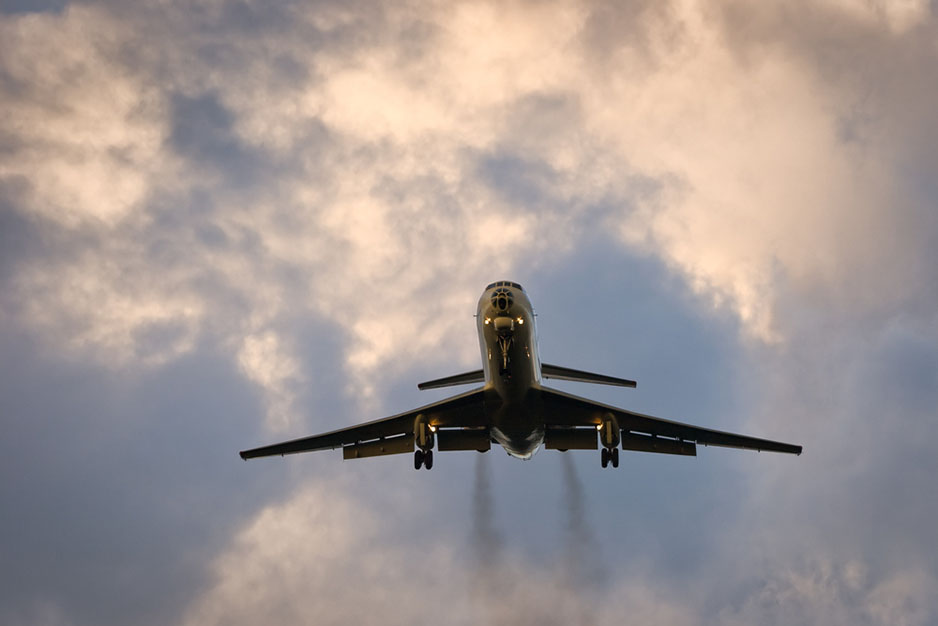
Emissions and sustainability
According to an MIT study, air freight has the most significant carbon footprint. On average, for every ton of goods shipped per mile, a cargo plane produces 47 times more greenhouse gases than a cargo ship.
Safety
According to the 2019 Allianz Safety & Shipping report, despite a 1,500 percent increase in container-carrying capacity, the sea shipping industry reported a 50 percent drop in lost vessels. This is a reduction to 49 incidents in 2020 and a total of 876 over the past decade.
Statistics compiled by the Flight Safety Foundation reported a total of 176 airliner fatalities in 2021, approximately 40 percent less than in 2019 (289) and 68 percent less than in 2018 (561).
The data indicates that not only are both shipping methods generally safe, but they are also getting safer every year.
Ship Safely and Confidently with Air Sea Containers
Air Sea Containers has decades of experience supplying customers with the packaging solutions they need for safe and secure international shipping. Whether you prefer to ship your goods by air or by sea, we offer a large selection of packaging materials, including boxes, cans, drums, pails and totes. Request a quote today, or contact us for more information.
Image Credits
davooda/Shutterstock.com
noknok69/Shutterstock.com
mariakray/Shutterstock.com
Alex Kolokythas Photography/Shutterstock.com
Travelpixs/Shutterstock.com
Aun Photographer/Shutterstock.com
Pierre-Yves Babelon/Shutterstock.com
heychli/Shutterstock.com
Oleg V. Ivanov/Shutterstock.com
Siwakorn1933/Shutterstock.com

